2020 Seminars
TiO2-Assisted Halide Ion Segregation in Mixed Halide Perovskite Films
November 18, 2020

Jeffrey DuBose is a fourth year graduate student advised by Prof. Prashant Kamat in the Department of Chemistry and Biochemistry. He presented "TiO2-Assisted Halide Ion Segregation in Mixed Halide Perovskite Films" at the ND Energy PD&GS Seminar in November 2020.
DuBose is a recipient of the 2020 Patrick and Jana Eilers Graduate Student Fellowship for Energy Related Research and the 2021 Forgash Fellowship for Graduate Student Research in Solar Energy. His research centers on improving the stability and performance of perovskites, a promising next-generation material for harvesting solar energy.
“The low-cost synthesis and high light conversion efficiency of perovskites make them attractive as transformative solar materials,” DuBose said. “An improved fundamental knowledge of how to make perovskites more stable is helping bring this material closer to market.”
While the solar energy field is already experiencing a great deal of growth due to falling prices of solar panels, perovskites have the potential to drive these prices even lower with their low cost and superior efficiency.
“With global energy demand quickly increasing, the world will need more renewable and clean energy solutions within the global energy portfolio to offset the environmental impact of greater energy demand,” DuBose said.
In addition to his work in the Kamat lab, DuBose collaborates with Prof. Masaru (Ken) Kuno's group as well. The expertise within the Radiation Laboratory and its affiliated faculty in solar energy materials, photochemistry, and nanomaterials was a major factor in DuBose’s decision to come to Notre Dame.
DuBose has found the university’s core facilities to be crucial for performing research. He has utilized instrumentation in the Notre Dame Integrated Imaging Facility, Center for Environmental Science and Technology, and ND Energy’s Materials Characterization Facility. He credits Ian Lightcap, research and facilities program director, for assisting with performing and understanding X-ray Photoelectron Spectroscopy (XPS) measurements.
DuBose earned his bachelor’s degree in Material Science and Engineering at the University of Arizona in 2017. As an undergraduate student, he hoped to boost his resume by getting involved in a research lab. Through this experience, he found excitement in addressing complex scientific problems and decided to pursue a Ph.D.
“One of the most important things I’ve learned by doing research is the balance between perseverance in tackling research projects and the need to quickly and critically assess results,” DuBose said, noting that it is possible to receive interesting results from experiments that may appear to “fail.”
“I’ve had an entire project birthed from what looked to me like a negative result. To the expert eye of my advisor Dr. Prashant Kamat, he was able to see the interesting phenomenon buried in the data,” he said.
Outside of the lab, DuBose is one of ND Energy’s most active associated researchers at outreach activities. He has volunteered at Art-2-Science summer camp, Science Alive, and has represented ND Energy at EdTech in the Bend. He has also had the opportunity to mentor two undergraduate Slatt fellowship scholars, Jake Drysdale (’20) and Brian Kang (’22).
DuBose’s experiences at Notre Dame have prepared him for a future in science, either in a university setting or at a national laboratory.
“I would consider it a success if I can pursue research and help others discover an interest in science,” he said.
Suppressing Cation Migration in Hybrid Perovskites
October 20, 2020
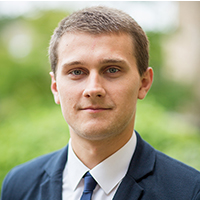
Ilia Pavlovetc is a fifth-year graduate student advised by Prof. Masaru (Ken) Kuno in the Department of Chemistry and Biochemistry. He presented "Suppressing Cation Migration in Hybrid Perovskites" at the ND Energy PD&GS Seminar in October 2020.
Pavlovetc’s research focuses on hybrid perovskites, important materials for third-generation (low cost/high efficiency) solar cells. Specifically, he is developing and applying novel approaches of optical microscopy for characterization of new semiconductor materials and optoelectronic devices.
“Better understanding of their optoelectronic performance will bring their commercialization a step closer,” Pavlovetc said.
In addition to his work in the Kuno lab, Pavlovetc has collaborated extensively with researchers on and off campus. He developed a new approach for super-resolution infrared imaging with ND Energy faculty affiliate Gregory Hartland, professor of chemistry and biochemistry.
Pavlovetc also works with a team at the National Renewable Energy Laboratory (NREL). Led by Joey Luther, senior scientist at NREL, the group has helped to prepare and conduct stability testing of solar cell devices.
Like many of ND Energy’s associated researchers, Pavlovetc has made great use of the Materials Characterization Facility (MCF). He works mostly with the ATR-FTIR and UV-Vis.
“While these instruments are quite basic, the information they provide is invaluable,” Pavlovetc said, noting that the MCF provides easy access to a number of materials characterization techniques.
After receiving his undergraduate degree in physics from IMTO University in Russia, Pavlovetc spent a few years working as an engineer before he arrived at Notre Dame in 2016. His primary interest in this field of research was to apply his knowledge of optics and physics to physical chemistry problems.
In 2020, Pavlovetc received the Forgash Graduate Fellowship for Solar Energy Research. Support from this fellowship has allowed him to present his findings at a number of national conferences. He has received additional funding for conferences from the Department of Chemistry and Biochemistry, The Graduate School, and the Graduate Student Union.
Pavlovetc believes it’s important for the general public to appreciate the amount of research that is necessary to produce the devices we use.
“Understanding of the research flow by the general public will possibly bring more attention to the basic research,” he said. “As a consequence, it might bring more money and people to research professions.”
Understanding the Interplay of Polymer Chemistry and Morphology on Polysulfide Transport in Metal-Sulfur Rechargeable Batteries
October 21, 2020
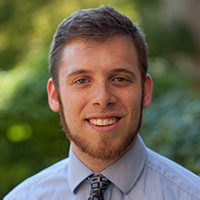
Hunter Ford is a fifth-year graduate student advised by Prof. Jennifer Schaefer in the Department of Chemical and Biomolecular Engineering. He presented "Understanding the Interplay of Polymer Chemistry and Morphology on Polysulfide Transport in Metal-Sulfur Rechargeable Batteries” at the ND Energy PD&GS Seminar in October 2020.
Ford received a 2020 Patrick and Jana Eilers Graduate Student Fellowship for Energy Related Research for his work in the field of energy storage. His focus is on rechargeable sulfur-based batteries, which have great potential for electric transportation.
“Sulfur-based batteries use cheap, ethical, and sustainable materials and hold the promise to store significant amounts of energy,” Ford said.
One of the major challenges with these batteries is the migration of the sulfur through the cell during operation. This causes the battery to lose capacity quickly. Ford is investigating ways to use polymers, or plastics, to keep the sulfur in the battery cathode so that the capacity is maintained through many cycles of charging and discharging.
“In addition to being well-suited for electric vehicles, sulfur batteries may be paired with renewable energy generation, such as solar and wind, to store energy from peak generation times to be used at peak consumption hours,” Ford said.
After graduating from Hope College in Holland, Michigan, Ford spent a few years in product engineering before deciding to return to school to get his Ph.D. His research interest in battery chemistry is inspired by the goal of transitioning to electric transportation to mitigate the effects of climate change.
“We must transition to a carbon neutral, or negative, society as fast as possible or face serious effects of climate change, such as loss of coastal regions and diminished food/water access, which may lead to geopolitical destabilization,” Ford said, adding that the transition to electric vehicles is an economic necessity as well. “If you want to have car manufacturing continue to be a successful American enterprise, we need to have the researchers and technology to make electric vehicles happen.”
To aid his research, Ford utilizes many instruments at the Materials Characterization Facility, such as the UV-Vis, FTIR, Raman microscope, and BET surface area analyzer. Other facilities he uses include the Notre Dame Integrated Imaging Facility and the Center for Environmental Science and Technology.
Outside of the lab, Ford helped develop a classroom module focused on batteries and polymers that will be used by ND Energy for K-12 outreach activities. This kit also will be scaled and distributed to teachers in the local community. After his initial involvement, the project was passed on to an undergraduate student Ford mentored, energy studies minor Emma Kerr.
Plutonium-EDTA: Solubility, Redox Behavior, and Aqueous Speciation
September 16, 2020
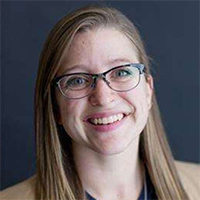
Nicole (Moore) DiBlasi is a fifth-year graduate student advised by Prof. Amy E. Hixon in the Department of Civil & Environmental Engineering & Earth Sciences. She presented "Plutonium-EDTA: Solubility, Redox Behavior, and Aqueous Speciation” at the ND Energy PD&GS Seminar in September 2020.
DiBlasi investigates the environmental interactions of nuclear waste components to ensure the proper disposal of nuclear materials. One of the major challenges to the widespread implementation of nuclear power generation are the environmental impacts of radioactive waste.
“I do research to help make sure plutonium does not end up in anyone’s groundwater,” DiBlasi said.
While an undergraduate student at the University of Missouri, DiBlasi became interested in the field of environmental radiochemistry after learning about the Hanford site, a decommissioned nuclear facility in Washington. After decades of plutonium production for the nation’s nuclear weapon arsenal, the Department of Energy is now tasked with the cleanup efforts of the radioactive waste. Under the supervision of Dr. Silvia Jurisson, DiBlasi investigated possible remediation pathways for Technetium-99 through mineral-mediated reduction processes.
“The field is so necessary, new, applied, and tangible,” DiBlasi said. “I love my research, because I feel that my experiments will actually make a measurable difference in how we dispose of used nuclear materials and approach radiochemical environmental remediation.”
Even if nuclear power is not used extensively in the United States, the presence of nuclear waste remains.
“To me, this means that the issue of used nuclear fuel should not be an obstacle to nuclear power,” DiBlasi said. “Just because we don’t implement nuclear power generation doesn’t mean we don’t have nuclear materials to deal with. So why make it an obstacle to such a wonderful energy option.”
In addition to working with the instrumentation in the Actinide Laboratories shared by the Burns and Hixon groups, DiBlasi has recently utilized the XPS at ND Energy’s Materials Characterization Facility.
By nature, her work is very collaborative not only on campus but also nationally and even internationally. DiBlasi works with the Actinide Chemistry and Repository Science Program (ACRSP) team at Los Alamos National Laboratory, which directly supports the research efforts for the Waste Isolation Pilot Plant in Carlsbad, New Mexico. She also works with the Aquatic Chemistry group (within the Radiochemistry section) at the Institute for Nuclear Waste Disposal at Karlsruhe Institute of Technology (KIT-INE) in Karlsruhe, Germany. DiBlasi spent three months conducting research at both of these sites.
“Notre Dame has allowed me the flexibility to learn not just from my cohort, Notre Dame professors, and my advisor, but also to travel the world and learn from the experts in my field,” DiBlasi said, crediting Hixon for her support and encouragement as a Ph.D. advisor. “She has fostered a group dynamic that is collaborative, supportive, and super fun to be a part of. I have not only found a group of lab mates that I love working with but also a great group of friends.”
DiBlasi is a member of the GLOBES certificate program in environment and society through the John J. Reilly Center for Science, Technology, and Values. GLOBES is an interdisciplinary training program designed to enhance a graduate student’s research and education by integrating skill sets from working in a secondary field of interest.
“Science is never truly a single discipline,” DiBlasi said. “Being able to work in an interdisciplinary setting and learn from people who think differently from you is truly invaluable.”
CISTAR: Responsibly Realizing the Potential of Shale Gas Resources
February 19, 2020

Graduate students Jerry Crum (Schneider lab), Zihan Huang (Guo lab), and Jessica Muhlenkamp (Hicks lab) gave a joint presentation about the Center for Innovative and Strategic Transformation of Alkane Resources (CISTAR) titled, "CISTAR: Responsibly Realizing the Potential of Shale Gas Resources" at the ND Energy PD&GS Luncheon in February 2020.
CISTAR is an engineering research center funded by the National Science Foundation (NSF). Notre Dame is one of five universities collaborating on the project with lead institution Purdue University, and partner institutions Northwestern University, University of Texas at Austin, and the University of New Mexico.
Although it is widely accepted that renewable sources will be the long-term solution for a more sustainable energy future, CISTAR intends to use the abundant shale resources in the U.S. as a bridge fuel until renewables can support our needs. The vision is to create new technologies that will economically convert the light hydrocarbons found in shale formations to petrochemicals and transportation fuels. Upgrading the surplus shale gas would cut down on the need to vent or flare it.
The new technologies have the potential to reinvent the petrochemical and transportation fuel industry with small, modular processing plants strategically located near the vast shale reserves. Novel catalytic materials are needed to meet the challenges of a smaller scale distributed processing system.
Within CISTAR, there are five research thrusts aimed at reducing the amount of wasted shale gas in the U.S. The presentation highlighted three of those research areas:
- Muhlenkamp’s focus is alkane dehydrogenation in Thrust 1. She studies how to remove two hydrogens from a carbon chain to make it active for Thrust 2.
- Crum is part of the alkene oligomerization team on Thrust 2. He looks at using zeolite catalysts to combine carbon chains.
- Huang works on gas separations in Thrust 5, which focuses mainly on providing oxygen that is essential for catalysis processes.
The nature of the large-center grant leads to collaborations not only within a campus, but also between the campuses of all partner institutions.
“We have two meetings each year, and even though we are working on different gas separations and catalysis, we talk a lot between us,” Huang said, noting that she is currently working on a project with collaborators from the University of Texas at Austin.
The computational work in the Schneider group lends itself to requests for models from various groups within CISTAR.
“As modelers, we’ve got this unique situation where we can help out with anybody who wants to understand their projects at an atomistic level,” Crum said.
Crum and Huang agreed that Notre Dame is the right place for them to conduct their research. Both lauded the sense of community among the graduate students that make their everyday interactions enjoyable. They were also complimentary of the well-connected faculty members in the Department of Chemical and Biomolecular Engineering who support and promote opportunities for collaboration.
“The resources that Notre Dame provides for our department, as well as the care and attention I get from the faculty has facilitated my growth as a researcher,” Crum said.
For Huang, the resources at Notre Dame include the instrumentation she uses at ND Energy’s Materials Characterization Facility (MCF).
“The research quality that can be done here is very impressive,” Huang said.
Along with administrative support, ND Energy provides education and outreach services for CISTAR. As the Student Leadership Council representative for Notre Dame, Crum makes sure all CISTAR graduate students are participating in the various outreach activities such as Science Alive and the TRiO program.
In addition to the five universities, CISTAR’s stakeholders include 29 industrial members and 13 innovation partners. The continuous interaction with companies is an attractive feature for graduate students to work on the project. Both Crum and Huang plan to go into industry after completing their graduate studies.
“I want my research efforts to be very directly put into the real world applications,” Huang said.
Identification and γ-Radiolysis of Thermal Transition Phases in Boehmite
January 15, 2020
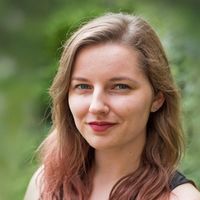
Patricia Huestis is a fifth-year graduate student advised by Prof. Jay LaVerne in the Radiation Laboratory. She presented "Identification and γ-Radiolysis of Thermal Transition Phases in Boehmite" at the January 2020 ND Energy PD&GS Luncheon.
Huestis examines aluminum minerals that are prevalent in legacy nuclear waste to understand the role that ionizing radiation has played in aging those materials. While LaVerne has traditionally done a lot of work related to nuclear reactors, Huestis is focused on the clean-up side of nuclear energy.
“Part of the argument against nuclear energy is that we have a lot of waste and we don’t know what to do with it,” Huestis said. “This work is progressing the field forward from a different perspective.”
As an undergraduate physics major at Missouri University of Science and Technology, Huestis took an interest in the nuclear energy industry through her minor in nuclear engineering. Notre Dame’s strong nuclear program and extensive campus resources attracted Huestis to the University for her graduate studies.
“If you go to radiation chemistry conferences, almost everyone there has been through the Notre Dame Radiation Laboratory, or they have an advisor or a student that has been through,” Huestis said. “So the Notre Dame Rad Lab is a world-renowned hub for radiation chemistry.”
In addition to the Radiation Laboratory, Huestis lauded the various facilities at Notre Dame such as the Nuclear Science Laboratory, Center for Environmental Science and Technology (CEST), and ND Energy’s Materials Characterization Facility (MCF). The campus provides a centralized location which allows researchers to maintain control of every step of the process.
“You can accomplish research here that would normally require you to go to multiple places or even hand off your samples,” Huestis said. “When you get to be involved in every aspect of data collection and analysis, you get a better experience. Not everyone has that luxury.”
Huestis has collected quite a bit of her thesis data through the use of several instruments at the MCF. Not only does the MCF remove the time-consuming and often expensive burden of maintaining equipment from individual labs, the facility’s staff also provides technical assistance and training to users. She praised the work of Dr. Ian Lightcap, research and facilities program director, and Anna Matzner, laboratory specialist.
“Whether it’s a new technique or a different way to use an instrument, Ian and Anna are willing to help users get data,” Huestis said. “This is especially true if we are doing something that’s a bit more on the experimental side.”
As one of the services available to associated researchers, ND Energy provided travel expense support for Huestis to attend the Miller Conference on Radiation Chemistry in Cumbria, United Kingdom. There she was able to give a talk and present a poster on her research.
Huestis will be defending her thesis at the end of February and will move on to a postdoctoral position at Los Alamos National Laboratory with the intention of eventually becoming a staff scientist.
Designing New Methodologies in Calorimetry to Define the Energy Landscape of Uranyl Peroxide Nanoclusters
January 15, 2020
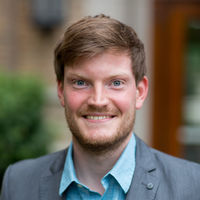
Hrafn Traustason is a fourth-year graduate student advised by Prof. Peter Burns in the Department of Chemistry and Biochemistry. He presented "Designing New Methodologies in Calorimetry to Define the Energy Landscape of Uranyl Peroxide Nanoclusters” at the ND Energy PD&GS Luncheon in January 2020.
One area of research in the Burns lab focuses on special uranium molecules called clusters. These clusters have promising applications in the nuclear fuel cycle, particularly in reprocessing spent nuclear waste.
“Nuclear fuel that has already gone through the power plant still retains at least 90-percent of its energy in the waste,” Traustason said. “Due to the large size of the clusters, the uranium could potentially be filtered out of the waste and returned to the start of the fuel cycle.”
The Burns lab has published over 60 different types of clusters, which vary in size. In order to determine how to filter the uranium in a safe manner, computational models need to be created to predict which of these clusters might be formed in the waste. Traustason’s specific role is providing the experimental data that can validate and optimize these models.
“I’m trying to break down the thermodynamic landscape of each of the clusters,” Traustason said. He is able to measure these thermodynamic values by using the calorimetry capabilities of the Burns lab and ND Energy’s Materials Characterization Facility (MCF).
Traustason’s daily routine includes running the calorimeters all morning and afternoon. In between, he synthesizes, or makes, clusters to study through a series of measurements.
“When you’re measuring something, you have to be sure that all of your material is what you think it is,” Traustason said. “We put a lot of emphasis into making sure our material is pure, so I do all sorts of purity measurements too.”
Originally from Iceland, Traustason was recruited on a swimming scholarship to Oakland University in Michigan, where he earned his bachelor’s in chemistry. To be more competitive in the job market, he decided to pursue an advanced degree.
Upon arriving at Notre Dame, Traustason rotated between three different faculty advisors for one month each to decide his placement. The availability of world-class instrumentation was a major factor in Traustason choosing the Burns lab.
“I saw this as an opportunity to learn how to use many different types of instruments and obtain skills that will help me get a job in the future,” Traustason said.
With no undergraduate research experience, Traustason has drawn on lessons from his swimming career to help adapt to the challenges of becoming a full-time chemist. He has found parallels between his time in the lab and the training that goes into preparing for a swim meet.
“In research there’s a lot of time when nothing happens, and then all of the sudden, there’s a breakthrough,” Traustason said. “Having that mentality where you don’t expect things to happen every day, but you keep grinding really helps.”